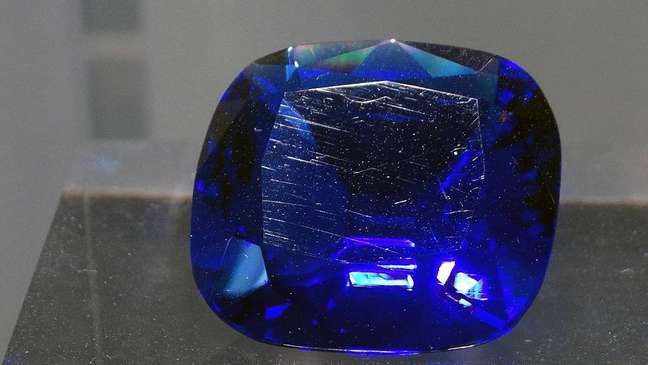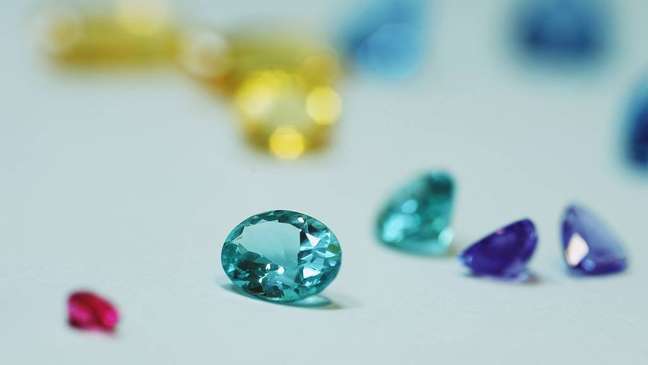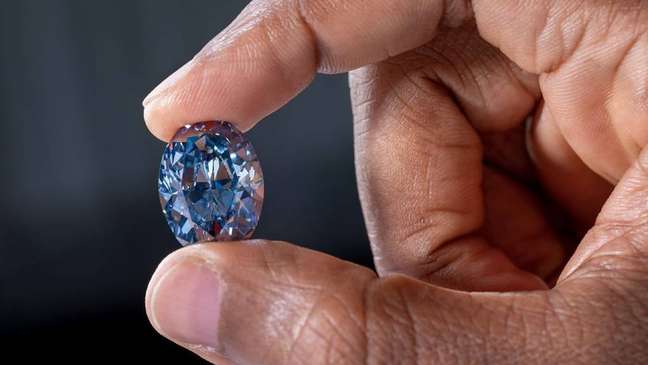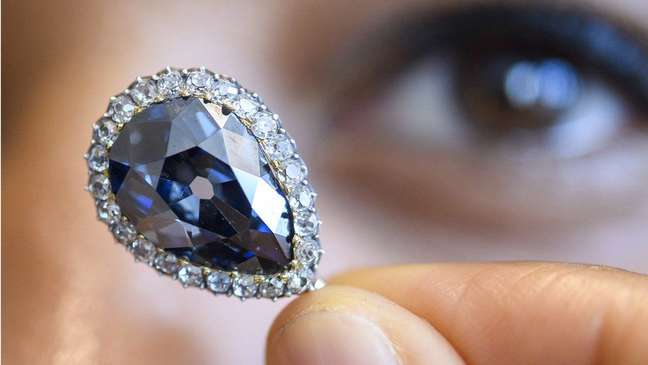The stunning, near-perfect Okavango Blue Diamond was first displayed at the North American Museum of Natural History in New York, United States.
Foto: Getty Images / BBC News Brasil
–
–
Known for their rarity, brilliance and beauty, diamonds were formed millions of years ago.
Currently, they can be a promise of eternal love, a display of wealth, or an object of desire. But in the past, healing properties were attributed to diamonds. Wearing them was believed to give strength and protection against all enemies and all evils – even nightmares.
In India he was related to Vedic and later Hindu deities. In the Mahayana Buddhist tradition, the Diamond Sutra, dated to 868 CE, states that it is a material that serves to “pass through the mundane illusion to illuminate what is real and eternal”.
But perhaps the most poetic were the ancient Greeks. To them, diamonds were tears shed by the gods or fragments of shooting stars.
What’s wonderful is that the truth about diamonds is almost as extraordinary as all these beliefs.
Diamonds are exceptional
Diamonds are composed of the same element that is the basis of life itself: carbon.
They are the hardest material there is and can withstand enough pressure to recreate the extreme conditions of the places where they were born. But when subjected to the right combination of heat and oxygen, they disappear, becoming just a gust of carbon dioxide.

The Hope Diamond (“Hope”), also known as “Le Bijou du Roi” (“The King’s Jewel”) or “Blue Tavernier”, is a large dark blue diamond weighing 45.52 carats.
Foto: Getty Images / BBC News Brasil
–
–
The bright ones form naturally in few places on Earth: deep in continental cratonic areas or at meteorite impact sites. And they come to the surface explosively, in the magma of some of the rarest eruptions in history – from the few volcanoes that have roots in the deepest parts of the planet.
Not all diamonds are transparent, nor do they have a yellowish or brown color, as we usually imagine them to be. There are also colored diamonds, which we call “fantasy color”: red, blue and green are rarer, while orange, violet, yellow and yellowish green are the most common.

Colored diamonds are called “fancy color” diamonds. Some, so rare, are very valuable.
Foto: Getty Images / BBC News Brasil
–
–
But, after their formation, they all have their own capacity to shelter and protect any mineral contained in their crystalline structures. This feature gives scientists a special insight into the mineralogy and conditions that exist miles deep below the planet’s surface.
In this sense, the blue diamond is exceptional.
Diamonds are deeply interesting
Most diamonds are formed at depths of about 150 km below the continents. But blue diamonds are born at four times greater depth, in the Earth’s lower mantle.

The Okavango Blue Diamond is a “dark blue fantasy color” diamond weighing 20.46 carats.
–
This was only discovered in 2018, as these gemstones “are immensely expensive, which makes it difficult to access them for scientific research purposes”, according to the lead author of the study that revealed this characteristic, geologist Evan Smith, from the Gemological Institute. North American.
Brilliant ones tend to be very pure and have no “inclusions” – small pieces of a non-diamond material that was nearby when the diamond was forming. But it is precisely these imperfections that provide scientists with more information.
It has already been possible to analyze 46 blue diamonds with inclusions and determine their origin between 410 and 660 km deep. Several of the samples even showed clear evidence that they originated more than 660 km below the surface – that is, in the lower mantle. This turns them into real time capsules, which contain information that is almost impossible to find elsewhere.
“We can’t get to the Earth’s interior. Diamonds form there and normally encapsulate whatever is down there,” George Harlow, geologist and curator of the Gem and Minerals Rooms at the North American Museum of Natural History, told the BBC. New York. “They’re like our space probes. Sometimes some come to the Earth’s surface so we can study them.”
An enigma shrouded in mystery
For most of history, blue diamonds have been a mystery. It was not known why its beautiful coloring.
Until it was finally discovered that the color was due to traces of boron, a metalloid chemical element that can enter the crystal lattice structure of a diamond during its growth.

The Azul Farnese diamond was a gift to Elizabeth Farnese, daughter of the Duke of Parma, Italy, for her marriage to King Felipe 5th of Spain in 1715.
Photo: EPA / BBC News Brazil
–
–
But as this mystery was solved, another enigma arose. If blue diamonds form in the Earth’s mantle and boron is concentrated in the crust, where did these diamonds get the boron? The answer to this geochemical riddle would give us clues about the depths of our planet.
The hypothesis put forward by the research group led by Smith is that boron came from the seafloor and was transported into the Earth’s mantle when one tectonic plate slid under another, in a process known as subduction. When incorporated into water-rich minerals, it can penetrate deep into the seafloor, all the way to the mantle part of the oceanic plate.
Finding traces of boron in diamonds that are born this far from the Earth’s surface indicates that water-bearing minerals travel much deeper into the mantle than previously thought, suggesting the possibility that a hydrological cycle exists at great depths.
As Harlow said, blue diamonds “are not only beautiful and rare, but extremely interesting. They teach us a lot about our planet.”
–


